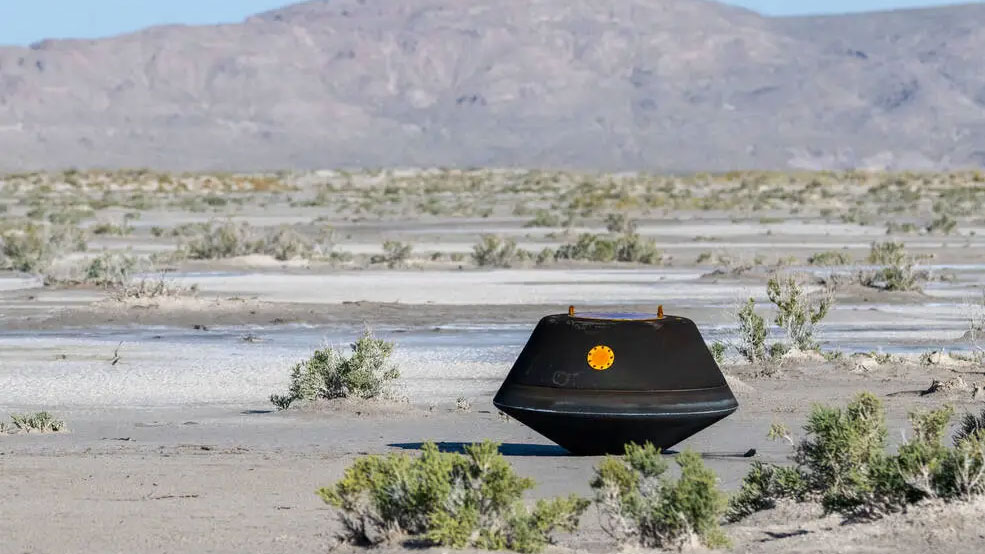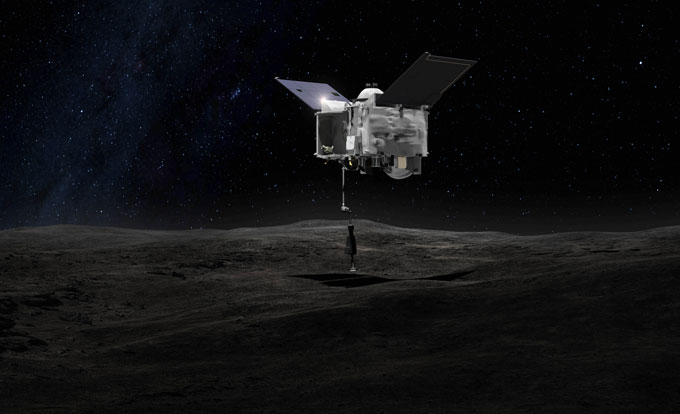NASA’s OSIRIS-REx spacecraft brought back bits of the asteroid Bennu
After dropping off the sample on Earth, the spacecraft is off to another asteroid

This capsule held a sample of the asteroid Bennu that was collected by the OSIRIS-REx spacecraft. It touched down in Utah on September 24.
NASA/Keegan Barber
Seven years is a long time to wait for a package delivery. But that’s how long it’s been since NASA’s OSIRIS-REx spacecraft set off to gather rocks and dust from the asteroid Bennu. At last, that package of asteroid bits has been safely delivered.
On September 24, OSIRIS-REx flew near Earth to drop off the package. This capsule held material from Bennu. The spacecraft had gathered the material in October 2020 before making the three-year journey home. The capsule initially plunged through Earth’s atmosphere. Shortly before landing, it popped a parachute and drifted down to Hill Air Force Base in Utah.
“This is a huge deal,” said James Garvin. He’s the chief scientist at NASA’s Goddard Space Flight Center in Greenbelt, Md. He was there at the Air Force base to witness the capsule’s landing. “This is the rarest stuff we’ve ever had on Earth,” he says.
These bits of Bennu could help reveal what sort of materials came together to build our solar system. They could also provide insights into the risks that nearby asteroids pose to us, if they were to fall into a collision course with Earth. The asteroid cargo may even hold clues to help answer one of the biggest questions in science: How did life begin?
Precious rubble
OSIRIS-REx is only the third mission to retrieve bits of an asteroid. And it’s the first for NASA and the United States. In 2005, the Japanese spacecraft Hayabusa returned micrograms of material from the asteroid Itokawa. In 2018, Japan’s Hayabusa2 collected five grams (less than a fifth of an ounce) from the asteroid Ryugu.
OSIRIS-REx’s sample is about 250 grams (a little more than a half-pound). That’s just a tad heavier than a cup of coffee. But it’s huge for a cache of asteroid material. NASA mission scientists weren’t sure they’d get even 15 grams, says Dante Lauretta. Even that, he said, “is an enormous amount of material in analytical chemistry.” Lauretta is a planetary scientist at the University of Arizona in Tucson. He leads the OSIRIS-REx mission.
NASA allows Lauretta and his team to keep only a quarter of the sample for their own use. Some will be given to scientists around the globe. The rest will be saved for future studies.
Collecting 60 grams from Bennu would have yielded enough for Lauretta’s team to study what they wanted. “The fact that we got over four times that is just phenomenally successful,” Lauretta says.
Stories Bennu can tell
Researchers are already envisioning all they can learn from Bennu.
“I’m really focused on … trying to understand if these kinds of carbon-rich asteroids may have delivered the seeds of life” to Earth, Lauretta says. “So we’re looking for things like amino acids, which are in our proteins.” His team will also search the Bennu samples for nucleic acids. Those are the building blocks of DNA.
There’s essentially no chance of finding anything alive on asteroids like Bennu, notes Lauretta. But the collected rocks and dust could help show how the puzzle pieces for life first started fitting together.
The Bennu bits may also reveal the potential for mining asteroids, says Mikael Granvik. This physicist works at the University of Helsinki and Luleå University of Technology in Sweden. He’s not a member of the OSIRIS-REx team.
Asteroids might one day be mined for water and raw materials to supply space missions, he says. Looking at Bennu samples could reveal if space travelers really could get such resources from space rocks. Maybe they could even use material from asteroids to build space stations instead of sending up parts from Earth, Granvik says.

Jessica Sunshine is more interested in what asteroid samples can tell us about how the solar system formed. She’s a planetary scientist at the University of Maryland in College Park.
“We think of [asteroids] as sort of dead rocks — and they’re not,” Sunshine says. “I mean, they have undergone significant [changes] — both chemical and physical — in the 4.5 billion years since they formed.” Like Lauretta, Sunshine hopes to learn how those processes ultimately led to the origins of life.
Studying near-Earth asteroids like Bennu also is crucial to understanding what threats these asteroids may pose. “In principle, [asteroids] could have given us life. And they could take it away,” Sunshine says. “I mean, from the dinosaurs’ perspective, they did take it away.”
Scientists don’t know of any killer asteroids headed for Earth. But they want to be prepared in case they ever discover one. That requires knowing the asteroids’ composition. “Depending on what they’re made of and how they’re [structured], it’s going to change their effect when they hit us. If they ever hit us,” Sunshine says.
Beyond Bennu
There may be more than bits of just Bennu in the return capsule, says Humberto Campins. This astronomer at the University of Central Florida, in Orlando, is part of the OSIRIS-REx team. On the whole, Bennu is a very dark rock. But there are some highly reflective boulders on its surface. Those bright chunks probably came from collisions with other asteroids, he says.
“There’s no guarantee. But I’m hoping that in our sample there will be some fraction, some pieces, grains that come from those other asteroids,” Campins says. Some of the bright pieces on Bennu look a lot like pieces of another asteroid called Vesta. “So we would have a sample return not just from Bennu, but … possibly from Vesta,” Campins says. “Or who knows what other asteroid.”
OSIRIS-REx’s mission doesn’t end with the package delivery in Utah. “The spacecraft is still healthy,” Lauretta says. Now it’s en route to another asteroid, Apophis. That space rock is about as far away from Earth as Bennu is.
For this next leg of its mission, the spacecraft gets a new name: OSIRIS-APEX. If all goes according to plan, it’s set to orbit Apophis in April 2029. But it won’t be bringing more samples back to Earth. Unlike your local delivery trucks, OSIRIS-REx was designed to carry only one package and make just a single delivery.







